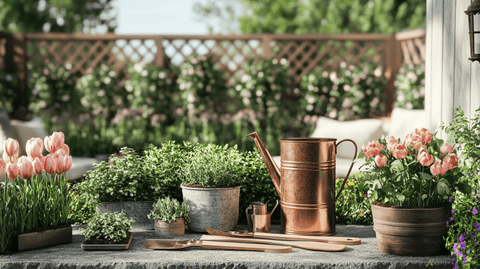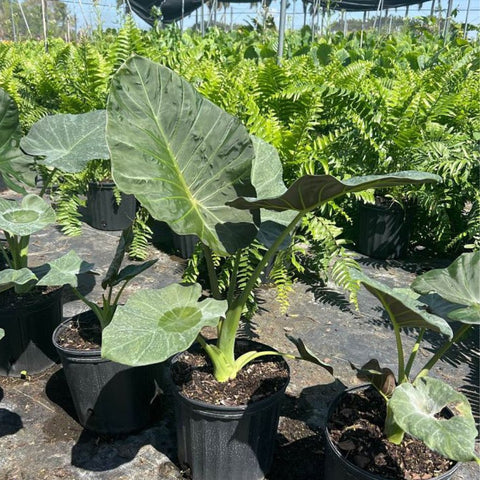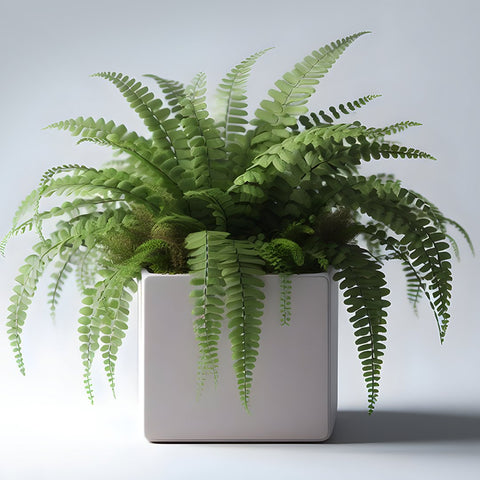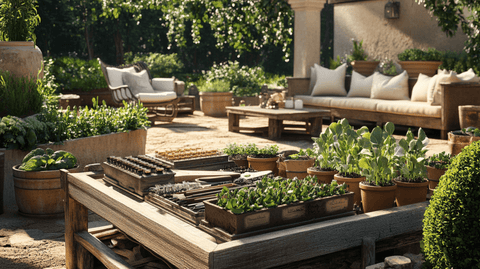Introduction
The joy of seeing the first sprouts of spring can be immensely rewarding, but achieving a bountiful garden requires the right preparation and tools. Spring planting is a time-honored tradition that marks the beginning of a new cycle of growth and renewal. However, a flourishing garden doesn't just happen by chance. It requires thoughtful planning, careful selection of plants, and most importantly, the right tools. As you embark on your spring planting projects, understanding the essential tools you need will be crucial in ensuring a vibrant and flourishing garden.

At Plantology, we are dedicated to providing all the necessary resources to make your planting endeavors successful. Our extensive range of plants, trees, and gardening accessories are designed to meet all your gardening needs. With this comprehensive guide, we’ll help you identify and utilize the key tools for efficient and thriving spring planting.
Preparing Your Garden for Spring Planting
Soil Preparation
The foundation of any successful planting project begins with soil preparation. The quality of your soil directly influences the health and growth of your plants. Without fertile and well-maintained soil, even the hardiest plants struggle to thrive.
Soil Testing
Start with testing your soil to determine its pH level and nutrient content. This crucial step helps you understand what type of amendments you might need to improve your soil structure and fertility. Soil test kits are an excellent investment and can be found at most gardening stores or online retailers. They help in identifying deficiencies in essential nutrients like nitrogen, potassium, and phosphorus.
Adding Nutrients and Amendments
Once you have identified the nutrient deficiencies, it's time to amend your soil. Organic compost, manure, and peat moss are popular choices that enrich the soil by adding essential nutrients and improving drainage. Compost also helps retain moisture, reduce weeds, and bolster soil life.
For gardeners looking to plant a variety of exotics like the Adonidia Palm Double or the Agave Blue, ensuring your soil is rich in nutrients is particularly crucial as these plants require specific conditions to thrive.

Essential Tools for Spring Planting
Hand Tools
Garden Trowels
A sturdy garden trowel is indispensable for digging, scooping, and transferring soil or compost. When selecting a trowel, opt for one with a comfortable grip and a carbon or stainless steel blade for durability.
Pruners and Shears
For cutting stems, small branches, or deadheading flowers, pruners and shears are essential. Bypass pruners are ideal for live plants, while anvil pruners work well for dead wood. Shears or scissors can be perfect for herbaceous plants or softer stems.
Digging Tools
Spades and Shovels
Spades are square-ended tools ideal for cutting through roots and moving soil. Shovels, with their pointed tips, are perfect for digging holes for transplants. Investing in ergonomic, durable tools can reduce fatigue and improve efficiency.
Hoes
Hoes are fundamental in preparing your garden beds. They help in clearing weeds, shaping soil, and creating furrows for planting seeds. Choose a hoe with the right weight and handle length to maximize comfort and productivity.
Watering Equipment
Proper watering is critical for the survival and growth of new plants. Various tools can assist in providing consistent and adequate moisture to your garden.

Watering Cans and Hoses
A watering can is essential for delicate watering, especially in pots or smaller gardens. For larger gardens, a hose with a spray attachment can provide even distribution. Consider investing in a soaker hose or drip irrigation system for efficient watering that conserves resources.
Moisture Meters
Understanding the moisture level in your soil is vital to avoid over- or under-watering. A soil moisture meter is an easy-to-use tool that helps monitor moisture levels, ensuring your plants receive just the right amount of water.
Selecting the Right Plants
Understanding Your Climate Zone
Choosing the right plants for your climate is crucial for your garden’s success. Use USDA Plant Hardiness Zones as a guide to select appropriate species that will thrive in your region's conditions.
For tropical climates, consider options like the Aglaonema Silver Bay for a lush, exotic look. If you're in a more arid region, drought-resistant plants like the Agave Caribbean are ideal for your landscape.
Planting Considerations
Sunlight Requirements
Different plants have varying sunlight needs ranging from full sun to full shade. Ensure that you understand these requirements and position your plants accordingly in the garden to maximize their growth potential.

Space and Maturity Size
Every plant has a mature size, and it's essential to plan for the growth space they will require. Overcrowding can lead to stunted growth and increased disease susceptibility. Research the expected size of your chosen plants and plan your layout to allow ample room for them to flourish.
Plant Combinations
Consider companion planting as a method to enhance the growth environment. Some plants provide mutual benefits when planted together, such as pest control or improved nutrient uptake. An example is pairing the Agapanthus Lily of the Nile with other sun-loving plants to create a harmonious garden.
Maintaining Your Spring Garden
Weed Control
Weeds compete with your plants for nutrients and water, so keeping them under control is essential. Tools like hoes and hand weeders are effective for managing these unwanted intruders. Consider using organic mulches like straw or wood chips to suppress weed growth while retaining moisture.
Pest and Disease Management
Monitoring for pests and diseases should be an ongoing process. Check plants regularly for signs of distress such as discolored leaves or holes. Integrate natural pest control solutions, such as predator insects or organic sprays, to maintain a healthy garden ecosystem.

Regular Pruning and Deadheading
Pruning helps maintain plant health by removing dead or diseased branches, promoting air circulation, and encouraging new growth. Deadheading, or removing spent flowers, directs a plant’s energy toward root and leaf development rather than seed production.
Tools such as bypass pruners are ideal for such maintenance tasks. For larger, more challenging projects involving trees, our Alexander Palm can provide beautiful architectural interest and will benefit from regular care to ensure its imposing stature stays healthy and attractive.
Advanced Tools for the Enthusiast Gardener
Power Equipment
Tillers and Cultivators
For larger gardens, tillers and cultivators are invaluable. They break up compact soil efficiently, allowing you to incorporate organic matter and prepare vast areas quickly. Opt for models suitable for your garden's size for optimal performance.
Greenhouses and Cold Frames
Greenhouses and cold frames extend the growing season by providing a controlled environment that protects seedlings from harsh weather. They allow for an earlier start to the planting season and the possibility to grow a wider variety of plants.
Soil Health Monitors
For more technologically inclined gardeners, soil health monitors can track not only moisture but also temperature and nutrient levels, providing a comprehensive overview of your planting conditions at any moment.

Plantology's Spring Planting Collection
With the right tools and plant selections at your disposal, achieving your dream garden is within reach. At Plantology, we take pride in offering quality products that cater to both novice and expert gardeners.
Explore our extensive range:
- Adonidia Palm Single - Perfect for adding a tropical touch.
- Agave Desmettiana Variegata - Ideal for modern desert landscapes.
Visit us at Plantology for more exceptional plants and expert advice to suit all your gardening needs.
Conclusion
Embarking on a spring planting project is both an exciting and rewarding endeavor. With the right tools and expertise, you can transform your garden into a thriving paradise. Whether you're a seasoned gardener or just starting, investing in high-quality equipment and diverse, suitable plants will pave the way for success.
By prioritizing essential tools and obtaining guidance from reliable sources like Plantology, your garden can reach its fullest potential. Don't wait for the perfect moment; start planning and shaping your dream garden today with Plantology as your trusted partner in cultivating nature's beauty.

Garden Design Inspirations
Creating a garden isn't just about planting; it's an expression of personal style. By incorporating design elements that resonate with your tastes, your garden will not only be a thriving space for plants but also a reflection of your unique aesthetic.
Formal Gardens
Characterized by symmetry and order, formal gardens often feature geometric layouts and structured paths. Hedges, topiaries, and well-defined borders are typical in such designs, providing a sense of elegance and discipline. Consider integrating stone pathways or decorative statues to elevate the formal garden aesthetic.
Cottage Gardens
Cottage gardens convey a sense of whimsy with their informal arrangements and dense plantings. A mishmash of blooming flowers, vegetables, and herbs provides both beauty and utility. Roses, foxgloves, and lavender are classic inclusions, creating a tapestry of colors and scents that resonate with timeless charm.
Zen Gardens
Zen gardens, or Japanese rock gardens, emphasize simplicity and tranquility using gravel, rocks, and minimal plantings. Incorporate elements like bamboo, ferns, or a peaceful koi pond to evoke a serene and contemplative environment. These gardens are designed to promote peace and reflection, perfect for moments of relaxation.
Eco-friendly Gardening Practices
As awareness of environmental issues grows, gardeners are increasingly seeking sustainable methods to reduce their ecological footprint. Adopting eco-friendly practices not only benefits the earth but also enhances the resilience and health of your garden.

Composting and Waste Reduction
Composting is a straightforward method of converting kitchen and garden waste into nutrient-rich soil amendments. This practice reduces landfill waste and supports a thriving soil ecosystem. Worm composting is another method, particularly effective for smaller spaces, and can be done indoors.
Water Conservation Techniques
Implementing water-saving solutions such as rain barrels and drip irrigation can drastically reduce water use. Designing gardens to include drought-tolerant plants and mulching can conserve water by retaining soil moisture, reducing the need for frequent watering.
Pollinator-friendly Practices
Encourage biodiversity by creating habitats that attract beneficial insects. Plant nectar-rich flowers to support bees, butterflies, and hummingbirds. Allowing native plants to flourish can promote a healthy ecosystem, reducing dependency on chemical pesticides.
In-depth Look at Garden Pests
Pests can quickly impact a garden’s productivity, and managing them effectively is crucial. Understanding common garden pests and their natural predators enables sustainable pest management that aligns with eco-friendly gardening principles.
Common Pests and Their Effects
Aphids, caterpillars, and slugs are among the most prevalent threats to garden health. Aphids can cause wilting and transmit diseases, while caterpillars may decimate leaves, impacting photosynthesis. Slugs and snails feed on tender plant parts, often ruining young sprouts before they mature.

Natural Predators and Pest Control
Ladybugs, lacewings, and spiders are valuable allies in the fight against garden pests, feeding on aphids and other insects. Birds, frogs, and toads can also help control pest populations naturally. Introducing or encouraging these predators reduces the need for chemical interventions.
Organic Remedies for Pest Control
Create homemade sprays using neem oil, garlic, or soap to deter unwanted pests without harming beneficial insects. Regular crop rotation and companion planting can naturally mitigate pest risks while promoting healthy growth. Regular inspection and maintenance ensure early detection and management of pest outbreaks.
Seasonal Planting Guide
Spring Planting Tips
Spring is a bustling time for gardeners, with myriad opportunities to set the stage for a vibrant growing season. Here's how to maximize your spring gardening efforts:
Timing Your Planting
Timing is vital; planting too early can risk frost damage, while planting too late might shorten the growing season. Use local climate data and historical average last frost dates to determine the optimal time to plant each species you intend to cultivate.
Starting Seeds Indoors
To get a head start on the growing season, consider starting seeds indoors. Creating a controlled environment with the proper lighting and temperature gives seeds a chance to germinate and grow into robust seedlings, ready to thrive outdoors when the time is right.

Planning for Continuous Harvest
To keep your garden productive throughout the spring and beyond, plan for successive plantings. Stagger planting dates or interplant early and late varieties. This approach ensures that you're harvesting fresh produce over an extended period.
Spring Blooming Flowers
Encourage a colorful start to the growing season by incorporating flowering plants like tulips, daffodils, and crocuses, which can transform any garden space with their vibrant hues and delightful scents.
Fertilization Strategies
Adopt an appropriate fertilization plan tailored to your plant selections. Slow-release granular fertilizers or liquid feeds can supplement soil nutrients as plants grow. Be mindful of the specific nutrient needs of each plant type to avoid over-fertilization, which can harm plants and pollute water sources.
Future Trends in Gardening
Technological Innovations
Technology is poised to revolutionize the gardening world. Smart gardening gadgets like automated watering systems, plant health apps, and drones for monitoring are becoming increasingly popular, making gardens more efficient and easier to manage.
3D-printed tools and structures are also gaining traction, allowing gardeners to customize solutions tailored to specific needs. By incorporating technology, gardeners can optimize resource use and improve plant care.

Edible Landscaping
Integrating edible plants into ornamental landscapes is a growing trend. Edible landscaping promotes sustainability by providing fresh produce while maintaining aesthetic appeal. Consider including fruit trees, berry bushes, or even vegetables like kale and pepper into your garden design for a productive and attractive space.
Growing Interest in Native Plants
Native plants are enjoying renewed interest due to their adaptability to local climates and ecosystems. By including native species in your garden, you can support local wildlife and reduce maintenance input, as they generally require less water and fewer chemical interventions.
The Rise of Indoor Gardening
As urbanization continues, indoor gardening is increasingly popular for those with limited outdoor space. Techniques such as container gardening, hydroponics, and vertical gardens enable city dwellers to enjoy the benefits of homegrown plants year-round.
Gardening as Therapy
Gardening’s mental health benefits are becoming widely recognized, with ‘horticultural therapy’ emerging as a method for promoting wellness. Engaging with nature, nurturing plants, and tending to a garden provide therapeutic stress relief and elevate overall well-being.

In conclusion, the evolution of gardening practices and tools reflects our growing understanding of sustainable living and aesthetic expression. Whether you're experimenting with cutting-edge technology or indulging in the simple pleasures of planting, gardening offers opportunities for creativity, relaxation, and fulfillment. Embrace the season, tools, and trends to cultivate a garden that's uniquely yours.






























Comments (0)
There are no comments for this article. Be the first one to leave a message!